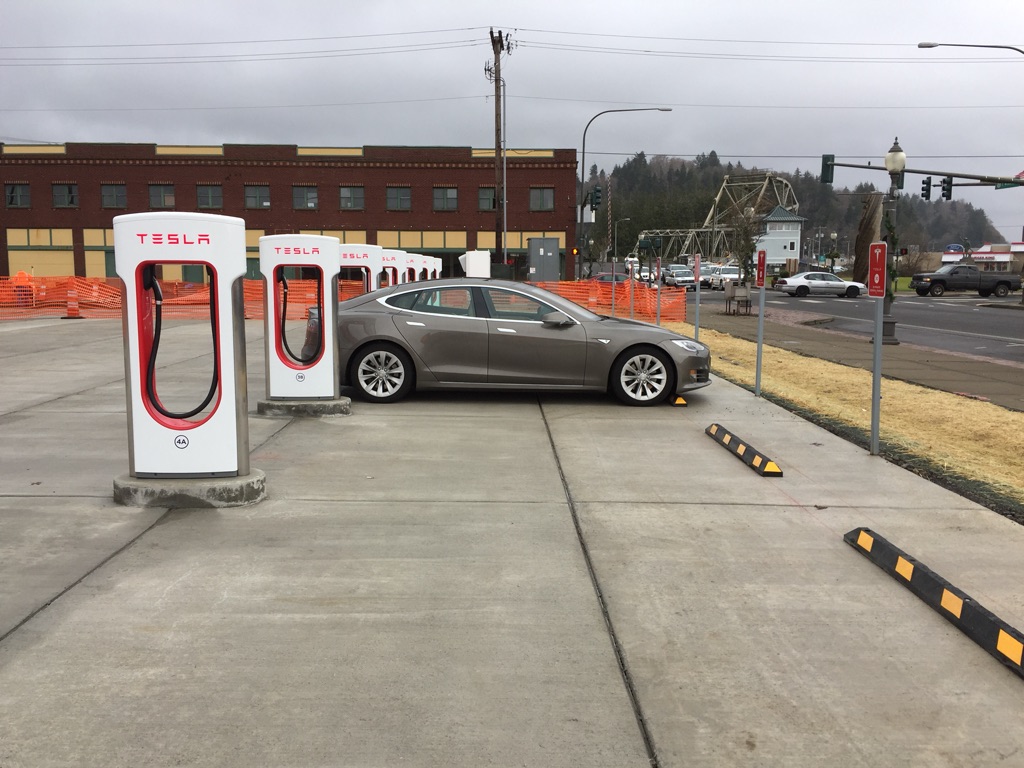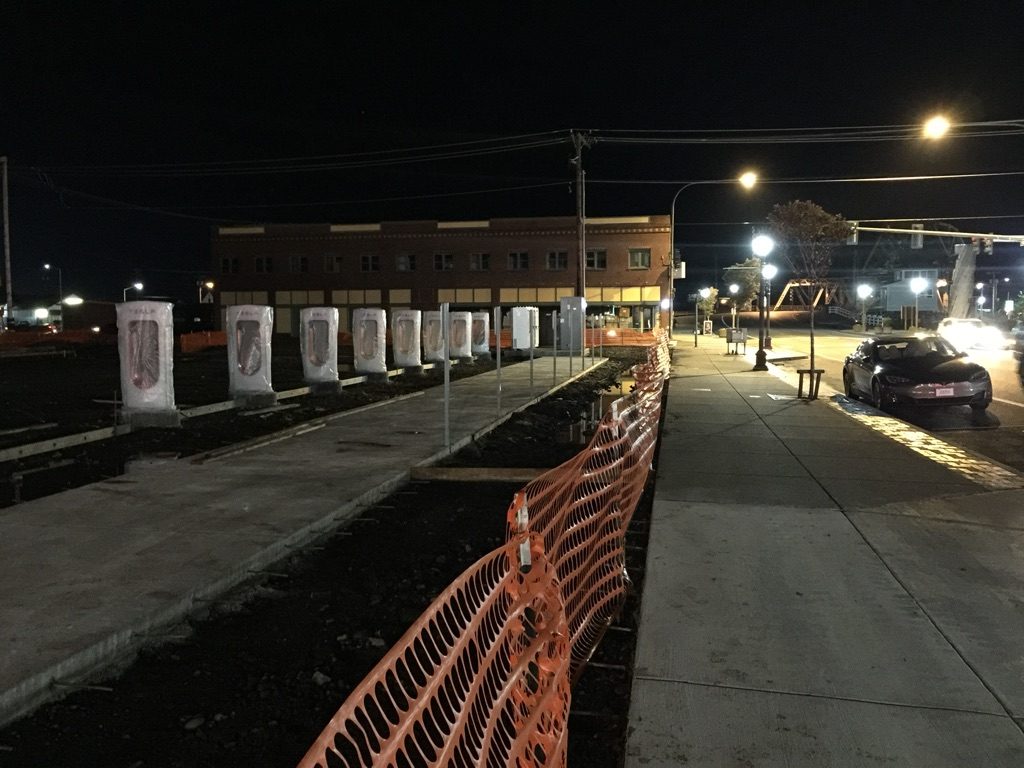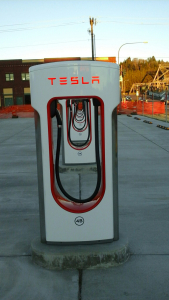News
Mayor tied to Tesla Supercharger site questioned over ‘conflict of interest’

He was young. Ambitious. Gifted. One of the greatest players to ever set foot on a professional baseball diamond, “Shoeless” Joe Jackson’s career ended in tatters for his alleged role in the infamous Chicago “Black Sox scandal” of 1919.
Call it a “conflict of interest.” It involved money. Lots of it.
Something else that involves money – lots of it – is afoot in Aberdeen, Washington: A Tesla Supercharger station and a “Gateway Center.” Aberdeen Mayor Erik Larson is a staunch proponent of both.
Updated: Mayor Larson fines himself $500 for violating the state’s conflict of interest ethics code
Mayor Larson is making the rounds looking for funding to help cover the costs of Gateway Center construction which is expected to cost upwards of $8M to complete, and incorporate Tesla’s Supercharger station into the design.
Questions within the community are swirling around what appears to be a conflict of interest regarding the mayor’s involvement in the Tesla deal. Documents have surfaced showing that the mayor has, or had, a financial interest in the electric car company that’s building the Supercharger station, apparently while he was negotiating with the company to bring the project to a city-owned lot. Why the station is being built on publicly owned land rather than on a private site is also in question.
Background
Mayor Larson negotiated the original agreement with Tesla for the charging station, which could have cost the city up to $2,000 a month in utility bills. The lease agreement came before the Aberdeen City Council for approval last summer. Originally, the City of Aberdeen was on the hook for paying electricity costs.

Tesla Supercharger station in Aberdeen, Washington during construction [Credit: Trebor Thickweb via app check-in]
As noted in the Aberdeen City Council meeting agenda dated July 13, 2016, the lease language at that time included (see page three):
“The Mayor has negotiated with Tesla Motors, Inc. for the construction of a Tesla supercharger station in Aberdeen on the city of the former Chevron station. The supercharger will be incorporated into the design of the Gateway Center. … the city will also be responsible for… paying the utility bills for Tesla vehicles that use the charging station, up to monthly cap of $2,000 per month.” (Emphasis added.)
Reading further, Item 8 of that actual lease agreement specifies that:
“Tesla agrees to arrange for all Tesla-related utility services provided or used in or at the Premises… Tesla shall pay directly to the utility company the cost of installation of any all such Tesla-related utility services and shall arrange to have the utility service separately metered. (Counterparty) shall be responsible for paying all utility bills related to such meter after installation, including payment for electricity consumed at the Premises during the Term, up to two thousand dollars ($2,000) per month.” (Emphasis added.)
Other Cities, Other Charging Stations
Tesla lease agreements with city governments aren’t new. Similar charging stations exist in five other Washington cities: Centralia, Burlington, Ellensburg, Kennewick, and Ritzville. There are eleven Supercharger stations in Oregon. All are located on either hotel/resort type private property or some other type of retail/outlet center. But the Aberdeen location is on a city-owned lot.
In California, two Supercharging stations on publicly owned property exist in Ukiah and Crescent City. But the terms negotiated by those cities for the stations are jarringly different from those negotiated for the Aberdeen site:
In Ukiah:
– “Tesla pays for the entire project, including staff time and utility costs.” (Ukiah Daily Journal, August 8, 2015.)
In Crescent City:
- The city is being paid by the tenant for use of its property. A proposal by Recargo, Inc. to build and operate a universal electric vehicle charging station in Crescent City included a $4,800 annual payment from Recargo to the district for use of the property. (Del Norte Triplicate, October 11, 2016.)
- “Essential components” of the city’s lease agreement with Tesla includes: “(1) the term, which is five years with two five-year options to renew, (2) Tesla will build and maintain the facility, and (3) the lease amount is one dollar per month.” (City of Crescent City Council Agenda Report, April 6, 2015.)
- Tenant “agrees to arrange for and pay for all Tenant-related utility services provided or used in or at the Premises during the term of the Lease.” (#10 – Utilities – City of Crescent City Ground Lease for Tesla Supercharging Station, April 6, 2015.)
- “Tenant shall pay directly to the utility company the cost of installation of any and all such Tenant-related utility services and shall arrange to have the utility service separately metered.” (#10, Utilities – City of Crescent City Ground Lease for Tesla Supercharging Station, April 6, 2015.)
In Aberdeen:
- The city (re: taxpayers) could get stuck with “up to 30,000 for the costs of installing the new infrastructure for the city” per the re-negotiated August agreement.
- The provision requiring the city to pay for electricity used by Tesla vehicles was removed.
- The proposed new lease requires Tesla to pay for all costs of charging Tesla vehicles.
- The lease also requires Tesla to install infrastructure “that would allow the city to add charging stations for other electric vehicles at some point in the future.”
- The city “will reimburse Tesla up to $30,000 for the costs of installing the new infrastructure for the city.” (Emphasis added.)
According to minutes from the August 24, 2016 Aberdeen City Council Meeting, a motion to adopt the re-negotiated lease agreement carried.
An interesting wrinkle, as announced by Tesla on November 7, 2016, is that Tesla has decided to stop offering unlimited free use of its network fast-charging stations worldwide beginning this year.
So, other than hopes of helping “attract potential tenants to the center as the first project participant” and providing “nearby restaurants and retailers with additional business” per Mayor Larson, just how, exactly, does the supercharging station tangibly benefit Aberdeen taxpayers or offset “up to $30,000” in reimbursements to Tesla “for the costs of installing the new infrastructure for the city”?
The Daily World reports that “A $30,000 grant will help Aberdeen reimburse Tesla for installing the station.” In light of the agreements hammered out with other cities for charging stations on public land, however, why is Aberdeen on the hook for reimbursing Tesla for any installation costs?
Another wrinkle:
According to an October 28, 2016 story in The Daily World, five Aberdeen sites were in the running as possible locations for the new Supercharger station, including the parking area for the Center. Larson explains:
“They (Tesla) could have easily worked with Gateway Mall or sought out private ownership, but they were interested in the Gateway Center parking lot.”
Why was a publicly owned site selected instead of a privately owned one? Is city government using public funds to compete with private business?
Additional questions swirl around Mayor Larson’s financial interest in Tesla Motors.
Some questions:
- Did Mayor Larson disclose his financial interest/common stock in Tesla Motor Company anywhere other than on his 2015 and 2016 PDC F-1 forms?
- As a candidate, Mayor Larson reported his stock value as $4.5K – $23.9K. After he was elected, he reported the value as $24K – 47.9K. What’s up with that?
- The mayor apparently handled all negotiations with Tesla, even though he had/has a financial interest in the motor company (See PDC F-1 forms, above). Did the city know about his financial interest in this company? If so, did it okay the mayor as negotiator of the Tesla lease agreement anyway? Why?
Perhaps a contract negotiator sans an apparent financial interest in the project under negotiation might be a good idea?
While we’re raising questions, what of Shoeless Joe? After the Black Sox scandal, Jackson never set foot on a professional baseball diamond again. He was banned for life along with seven other Chicago players for their alleged involvement in intentionally throwing the 1919 World Series to the Cincinnati Reds. Jackson’s alleged involvement in the conspiracy is still the subject of hot debate. Some maintain that the only things Joe was guilty of were being young, ambitious, gifted, and a bit naive.
Ring any bells?
Kristine Lowder
This guest post was written by Kristine Lowder of Conservelocity. Do you have a post you’d like to share? Email it to us at info@teslarati.com

Elon Musk
Elon Musk’s X will start using a Tesla-like software update strategy
The initiative seems designed to accelerate updates to the social media platform, while maintaining maximum transparency.

Elon Musk’s social media platform X will adopt a Tesla-esque approach to software updates for its algorithm.
The initiative seems designed to accelerate updates to the social media platform, while maintaining maximum transparency.
X’s updates to its updates
As per Musk in a post on X, the social media company will be making a new algorithm to determine what organic and advertising posts are recommended to users. These updates would then be repeated every four weeks.
“We will make the new 𝕏 algorithm, including all code used to determine what organic and advertising posts are recommended to users, open source in 7 days. This will be repeated every 4 weeks, with comprehensive developer notes, to help you understand what changed,” Musk wrote in his post.
The initiative somewhat mirrors Tesla’s over-the-air update model, where vehicle software is regularly refined and pushed to users with detailed release notes. This should allow users to better understand the details of X’s every update and foster a healthy feedback loop for the social media platform.
xAI and X
X, formerly Twitter, has been acquired by Elon Musk’s artificial intelligence startup, xAI last year. Since then, xAI has seen a rapid rise in valuation. Following the company’s the company’s upsized $20 billion Series E funding round, estimates now suggest that xAI is worth tens about $230 to $235 billion. That’s several times larger than Tesla when Elon Musk received his controversial 2018 CEO Performance Award.
As per xAI, the Series E funding round attracted a diverse group of investors, including Valor Equity Partners, Stepstone Group, Fidelity Management & Research Company, Qatar Investment Authority, MGX, and Baron Capital Group, among others. Strategic partners NVIDIA and Cisco Investments also continued support for building the world’s largest GPU clusters.
News
Tesla FSD Supervised wins MotorTrend’s Best Driver Assistance Award
The decision marks a notable reversal for the publication from prior years, with judges citing major real-world improvements that pushed Tesla’s latest FSD software ahead of every competing ADAS system.

Tesla’s Full Self-Driving (Supervised) system has been named the best driver-assistance technology on the market, earning top honors at the 2026 MotorTrend Best Tech Awards.
The decision marks a notable reversal for the publication from prior years, with judges citing major real-world improvements that pushed Tesla’s latest FSD software ahead of every competing ADAS system. And it wasn’t even close.
MotorTrend reverses course
MotorTrend awarded Tesla FSD (Supervised) its 2026 Best Tech Driver Assistance title after extensive testing of the latest v14 software. The publication acknowledged that it had previously criticized earlier versions of FSD for erratic behavior and near-miss incidents, ultimately favoring rivals such as GM’s Super Cruise in earlier evaluations.
According to MotorTrend, the newest iteration of FSD resolved many of those shortcomings. Testers said v14 showed far smoother behavior in complex urban scenarios, including unprotected left turns, traffic circles, emergency vehicles, and dense city streets. While the system still requires constant driver supervision, judges concluded that no other advanced driver-assistance system currently matches its breadth of capability.
Unlike rival systems that rely on combinations of cameras, radar, lidar, and mapped highways, Tesla’s FSD operates using a camera-only approach and is capable of driving on city streets, rural roads, and freeways. MotorTrend stated that pure utility, the ability to handle nearly all road types, ultimately separated FSD from competitors like Ford BlueCruise, GM Super Cruise, and BMW’s Highway Assistant.
High cost and high capability
MotorTrend also addressed FSD’s pricing, which remains significantly higher than rival systems. Tesla currently charges $8,000 for a one-time purchase or $99 per month for a subscription, compared with far lower upfront and subscription costs from other automakers. The publication noted that the premium is justified given FSD’s unmatched scope and continuous software evolution.
Safety remained a central focus of the evaluation. While testers reported collision-free operation over thousands of miles, they noted ongoing concerns around FSD’s configurable driving modes, including options that allow aggressive driving and speeds beyond posted limits. MotorTrend emphasized that, like all Level 2 systems, FSD still depends on a fully attentive human driver at all times.
Despite those caveats, the publication concluded that Tesla’s rapid software progress fundamentally reshaped the competitive landscape. For drivers seeking the most capable hands-on driver-assistance system available today, MotorTrend concluded Tesla FSD (Supervised) now stands alone at the top.
News
Elon Musk’s Grokipedia surges to 5.6M articles, almost 79% of English Wikipedia
The explosive growth marks a major milestone for the AI-powered online encyclopedia, which was launched by Elon Musk’s xAI just months ago.

Elon Musk’s Grokipedia has grown to an impressive 5,615,201 articles as of today, closing in on 79% of the English Wikipedia’s current total of 7,119,376 articles.
The explosive growth marks a major milestone for the AI-powered online encyclopedia, which was launched by Elon Musk’s xAI just months ago. Needless to say, it would only be a matter of time before Grokipedia exceeds English Wikipedia in sheer volume.
Grokipedia’s rapid growth
xAI’s vision for Grokipedia emphasizes neutrality, while Grok’s reasoning capabilities allow for fast drafting and fact-checking. When Elon Musk announced the initiative in late September 2025, he noted that Grokipedia would be an improvement to Wikipedia because it would be designed to avoid bias.
At the time, Musk noted that Grokipedia “is a necessary step towards the xAI goal of understanding the Universe.”
Grokipedia was launched in late October, and while xAI was careful to list it only as Version 0.1 at the time, the online encyclopedia immediately earned praise. Wikipedia co-founder Larry Sanger highlighted the project’s innovative approach, noting how it leverages AI to fill knowledge gaps and enable rapid updates. Netizens also observed how Grokipedia tends to present articles in a more objective manner compared to Wikipedia, which is edited by humans.
Elon Musk’s ambitious plans
With 5,615,201 total articles, Grokipedia has now grown to almost 79% of English Wikipedia’s article base. This is incredibly quick, though Grokipedia remains text-only for now. xAI, for its part, has now updated the online encyclopedia’s iteration to v0.2.
Elon Musk has shared bold ideas for Grokipedia, including sending a record of the entire knowledge base to space as part of xAI’s mission to preserve and expand human understanding. At some point, Musk stated that Grokipedia will be renamed to Encyclopedia Galactica, and it will be sent to the cosmos.
“When Grokipedia is good enough (long way to go), we will change the name to Encyclopedia Galactica. It will be an open source distillation of all knowledge, including audio, images and video. Join xAI to help build the sci-fi version of the Library of Alexandria!” Musk wrote, adding in a later post that “Copies will be etched in stone and sent to the Moon, Mars and beyond. This time, it will not be lost.”









